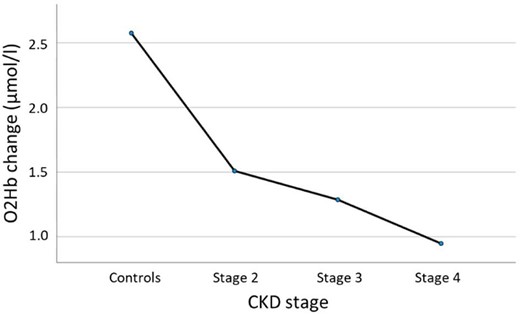-
PDF
- Split View
-
Views
-
Cite
Cite
Marieta Theodorakopoulou, Andreas Zafeiridis, Konstantina Dipla, Danai Faitatzidou, Aggelos Koutlas, Maria Eleni Alexandrou, Georgia Polychronidou, Georgios Chalkidis, Aikaterini Papagianni, Pantelis Sarafidis, FC085: Cerebral Oxygenation During Exercise Across Different Stages of Chronic Kidney Disease, Nephrology Dialysis Transplantation, Volume 37, Issue Supplement_3, May 2022, gfac116.001, https://doi.org/10.1093/ndt/gfac116.001
Close - Share Icon Share
Abstract
Cognitive impairment and reduced exercise tolerance are common in patients with chronic kidney disease (CKD), in part due to reduced brain function. Proper brain function relies on sufficient blood flow and oxygen supply by the cerebral vasculature. A reduction in cerebral oxygenation of more than 10% may deteriorate brain function and influence the decision to continue exercise. This study aims to examine the cerebral oxygenation and blood volume during a mild physical stress as an index of brain activation in patients at different stages of CKD and controls without CKD.
This is a preliminary analysis of an observational study enrolling patients with CKD stage 2–4 (matched for age and sex within the different stages) and controls without CKD. All participants underwent a 3-min intermittent handgrip exercise (HG) at 35% of their maximal voluntary contraction. Changes in prefrontal oxygenation (oxyhaemoglobin—O2Hb) and deoxyhaemoglobin—HHb) and total blood volume (total hemoglobin—tHb) were continuously recorded during HG-exercise by near-infrared spectroscopy (NIRS).
A total of 59 participants are included in this preliminary analyses (n = 11 controls, n = 15 stage 2 CKD, n = 18 stage 3 CKD and n = 15 stage 4 CKD patients). During HG-exercise, O2Hb significantly increased (P < 0.001) and HHb remained relatively unchanged in all groups compared to pre-exercise values. However, this O2Hb increase was progressively lower with advancing CKD Stages (controls: 2.58 ± 1.43; stage 2: 1.51 ± 1.31; stage 3: 1.29 ± 0.97; stage 4: 0.95 ± 0.92; P = 0.006) (Figure). During HG, tHb (an index of microvascular blood volume) increased significantly in controls, stage 2 and stage 3 CKD patients (P < 0.05) but not in stage 4 CKD patients (P = 0.100). As before this tHb increase was progressively lower with advancing CKD stages (P = 0.030). Controlling for age differences between groups did not alter the above observations.
Brain activation/response during a mild physical task appears to decrease with advancing CKD as suggested by the smaller rise in cerebral oxygenation and blood volume. This may contribute both impaired cognitive function and reduced exercise tolerance with advancing CKD.

- vascular flow
- alveolar ventilation function
- kidney failure, chronic
- exercise
- hemoglobin
- blood volume
- exercise tolerance
- mental processes
- oxyhemoglobins
- spectroscopy, near-infrared
- brain
- cell respiration
- stress
- oxygen delivery
- cognitive impairment
- deoxyhemoglobin
- brain activity
- brain function
- cognitive ability
- vasculature of brain





Comments